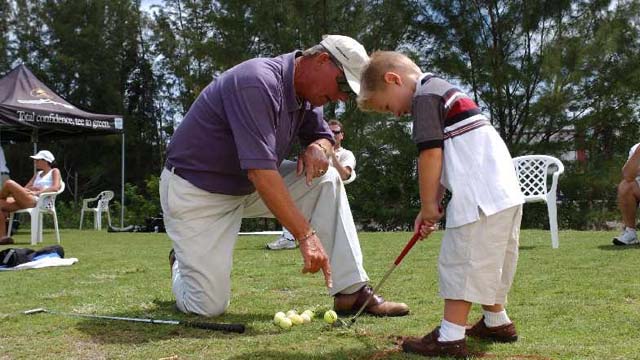
In this lesson, we’ll teach you how to teach your kids the full swing.
To start off, you must reinforce the last two lessons on both putting and chipping. An easy way to demonstrate this, is by grabbing an iron and showing kids the putting stroke, and gradually swing bigger until you’re chipping, and then slowly progress to a full swing. However, as soon as you’re done, kids are going to want to swing a club, and it’s incredibly important to discuss safety first, as most kids won’t know how dangerous golf clubs and balls can be. Be very clear that before anyone makes a swing, there should be aware of where the people are around them.
Next up, ask the kid(s) to drop the clubs and leave them on the ground – insist that before they learn to swing, they need to learn how to move the body and arms. Get your kid(s) to start with their feet shoulder width apart, or maybe little wider, explain that for a full swing you need a wider stance for balance. Get them to start with their hands on their hips and then mimic the body weight movements during a swing. Coil your body back as you would on your back swing (and get them to face you and say “hello”), then turn through the hitting area and through to finish. In the finish, explain to the kids that a good finish has your body facing the target, knees are touching and rear foot is on its toe. This is called the hello drill. Get them to turn back, say hello, and then turn through to face the target, and have their rear foot on its toes and knees touching. If it helps, have them envision balancing a glass on the back heel.
Next up is the arm movements. This is what we call the point the thumbs drill. Start with you kid(s) in a normal setup, but have their hands in a clapping position at address. Their palms together, and thumbs pointing down to the ground. Just like in the hello drill, have them turn back towards you, and now their thumbs should point over their shoulder towards the target. Then as the follow-through to finish their thumbs should point behind them away from the target. After some practice, they should catch on. Next up – bring on the clubs.
A note on clubs – usually, if you cut down a club for a youngster it will be too heavy and too stiff. Consider getting clubs specially made for kids, that use lightweight materials and extra flexible shafts. This will make swinging the club much easier, and help avoid poor technique due to them not having the strength to swing the overweighted club properly.
Get your kid(s) with clubs (no balls yet) and in their setup position. Check their grips again (as kids tend to like to change them up to something more natural). Reinforce the importance of safety, and then get them to repeat the thumbs drill, this time with a club in hand. If some of your kids have trouble with hitting the ground, encourage them to try to just sweep the grass instead. At this point, you’re just looking for complete uninterrupted swings. Make sure the kids are holding their finish positions – this is very important.
Ball position is next, and this is where the last drill comes into play – the tee drill. Place a tee an inch or so above the ground in the center of their stance. Depending on the length of the club the child has, see where the club’s sole is level on the ground – this should be where the tee goes. Next, get your kid(s) to nick the tee with their swing. Reinforce the same thumbs drill, and hold your finish.
Finally, grab some balls, once again reinforce everything you’ve previously taught them, especially safety, and get them hitting balls. Make a small competition of it to make it more fun. They’ll be pros in no time.
Photo credit: pga.com
